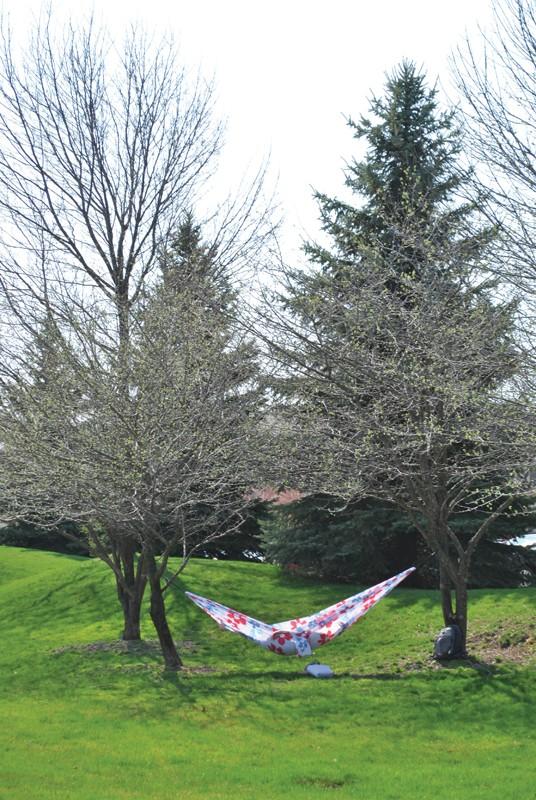GV fairs well in summer heat wave, has concerns about long-term effects of warm weather

GVL / Archive A student lounges in a hammock on campus to sway the ongoing heat.
Jul 15, 2012
While for some, recent bout of record temperatures combined with absence of rain have shriveled up lawns into patches of hay and killed their flowers and gardens, Grand Valley State University grass doesn’t resemble other lawns outside of it’s campus. In fact, workers haven’t broken a sweat in the face of the hot, dry temperatures – which has earned their place in the history books as the hottest summer on record in the U.S., and globally as the hottest decade in the world – while officials say the benefits of “going green” have worked in the university’s favor.
“Water is a concern,” said Bart Bartels, campus sustainability manager. “Because of natural landscaping and retention ponds, water usage on campus is about 25 million fewer gallons than we used in 2005 so on the consumption side we are moving the right direction.”
Thanks to a drip irrigation system, the campus is looker greener than the surrounding areas to provide that golf course green grass that seems rare to find this summer.
One has recently been installed at the Sustainable Agriculture Project located on Luce Street, just south of campus.
“The heat hasn’t really affected the garden tremendously,” said Levi Gardner, community garden manager for SAP. “If we had a couple more days at 100 degrees, it could be dangerous.”
The garden grows around 30 crops and sells them at the Farmer’s Market on campus. Gardner said that they only lost a few crops like broccoli, lettuce and spinach that can be easily ruined by just 85 degree heat, but “the extreme heat is moot.”
Since they have the irrigation system, the plants have been getting water, despite no rain clouds in weeks.
However, Gardner concerns for the garden are at a “macro-level.” He said the bean and corn fields need to get water soon or the results might be devastating.
“We moderate things very closely,” Gardner said. “We have a diverse production and grow year. We are prepared for adapting.”
Gardner said that the summer’s heat isn’t a major problem, but will require adjustments and tweaking with dates, such as the spinach will be planted later since it doesn’t do well with the heat.
“Facilities planning has done a great job of laying out an elaborate irrigation system so the campus is looking much greener than the surrounding area,” Bartels said, “but it would be nice to get an extended shower to refill the ponds.”
Terry Pahl, facilities engineer, energy manger and project manager, said that heat couldn’t have come at a better time, adding that the heat provides a “great test environment” for facilities.
“We are in the process of experimenting in some areas with new irrigation nozzles that may provide better coverage, “ Pahl said. “We are also experimenting with limitations on watering time frames.”
In addition to an irrigation system, GVSU has porous asphalt pavement that captures storm water and release it at a controlled rate, porous concrete that collects storm water and pumps into the irrigation system, and retention ponds that keeps GVSU’s lawns green despite mother nature. Other than providing an exceptional testing environment, facilities had to increase the load on air conditioning, but it didn’t exceed their capacity.
Like Gardner, Bartels’s worries are about the long-term effects of climate change rather than this summer’s heat wave.
“The climate is changing at an ever accelerating rate,” he said. “Unfortunately many aren’t concerned until their well runs dry or the power goes out. In an effort to reduce GVSU’s impact on the planet, President Haas has signed the President’s Climate Commitment to cut our carbon footprint as fast as possible. “

























